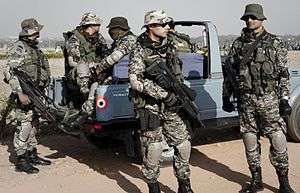Garud Commando Force
| Garud Commando Force गरुड़ कमांडो बल | |
|---|---|
|
Garud Commandos at Aero India 2011 | |
| Founded | 6 February 2004 |
| Country |
|
| Branch |
|
| Type | Special Forces |
| Role |
Direct Action Airfield Seizure Special Reconnaissance Airborne Operations Air Assault Unconventional Warfare Counter Terrorism Foreign Internal Defence Special Operations Combat Search and Rescue COIN Special operations |
| Size | Classified (estimated at 1080 personnel) |
| Headquarters | New Delhi |
| Motto(s) | ॥प्रहार से सुरक्षा॥(Translation: Defence by Offence) |
| Engagements |
MONUC (Congo) Security during Aero India 2005/2007/2011/2013 Kashmir conflict 2016 Pathankot attack Insurgency in Jammu and Kashmir |
| Insignia | |
| Commando Badge |
 |
The Garud Commando Force is the special forces unit of the Indian Air Force. It was formed in September 2004 and has a current strength of approximately 1080 personnel.[1][2] The unit derives its name from Garuda, a divine bird-like creature of Hindu Mythology.
Garud is tasked with the protection of critical Air Force bases and installations; search and rescue during peace and hostilities and disaster relief during calamities.[3] Presently, Garud's are deployed in Congo as part of the UN peace keeping operations.
History
After attempts by terrorists to attack two major air bases in Jammu and Kashmir in 2001, Indian Air Force commanders felt the need for a specialized force to protect these critical elements and to have a dedicated Commando Force trained in Special Forces techniques, Combat Search and Rescue, Reconnaissance, Counter Insurgency (COIN) Operations and Emergency in response to terror-threats to airfields.
While the Army might have provided some Special forces units to the Air Force, its units were always subject to being posted out on rotation to other areas as per the Army's requirements. It was felt that the specialized training the air force would have provided such units would have to be repeated again and again for the replacement units.
The initial plans mooted in October 2002 called for a specialized force with 2000 commandos. The group was originally called "Tiger Force", but was later renamed as "Garud Force".[4]
In order to address the need for a dedicated force, in September 2003, the Government of India authorized a 1080 strong force to be raised and trained on the lines of the Para commandos of the army and MARCOS of the Indian Navy,[3] with the mandate of performing niche, Air Force specific operational tasks.
Soon after, the first batch of 100 volunteers from the IAF No.1 Airmen Training Center at Belgaum, Karnataka were earmarked to undergo Garud Training at Gurgaon. The Garuds were first unveiled on 6 February 2004, when the first batch of 62 "Air Commandos" passed out of training in New Delhi.[5][6][7] The Garuds were first seen publicly during the Air Force Day celebrations at New Delhi on 8 October 2004.[8]
In the aftermath of the Pathankot Terror Attack, Indian Air Force decided to raise ten additional squadrons of Garud commandos, comprising about 700 personnel, bringing the total strength of the force to 1780.[1][2][9]
Responsibilities
| Indian Air Force |
|---|
 Nabha Sparsham Deeptam "Touch the Sky with Glory" |
| Headquarters |
| History and traditions |
| Aircraft |
| Installations |
| Personnel |
Garuds have diverse responsibilities. Besides base protection force to protect airfields and key assets in hostile environments, some advanced Garud units are trained like Army Para Commandos and the Naval MARCOS to undertake missions deep behind enemy lines. Note, that the security of IAF installations like radars, airfields and other establishments in border areas is generally performed by the Air Force Police and the Defence Security Corps (DSC).[10]
Wartime duties
During hostilities, Garuds undertake combat search and rescue, rescue of downed airmen and other forces from behind enemy lines, suppression of enemy air defence (SEAD), radar busting, combat control, missile and munitions guidance ("lasing" of targets) and other missions in support of air operations. It has been suggested that they undertake an offensive role including raids on enemy air bases etc. during times of war.
Apart from protecting air bases from sabotage and attacks by commando raids, they are also tasked to seal off weapons systems, fighter hangars and other major systems during intrusions and conflicts.[4]
Peacetime duties
During peace time, apart from protecting the air bases and other vital infrastructure from terrorist attacks, Garud roles include counter terrorism, anti-hijacking, hostage rescue, aid during natural calamities and military tasks in the interest of the nation.[7]
As in the case of the failed attack on Awantipur AFS in October 2001, Garuds act as an emergency terror-response team.
Organization
Garud personnel are enlisted as Airmen within the Indian Air Force rank structure. The entire force is currently under the command of a Wing Commander rank officer. The Garud force is organized into fifteen "Flights" - a flight is roughly the equivalent of a company in an infantry battalion, and is commanded by a Flight Lieutenant. Each flight is based at various Air Force stations, where they train and provide security. The Garud Commando Force has a total present strength of approximately 1080 airmen.[7][1][2]
Training

Airmen Selection Process
Unlike its counterparts in the Army and Navy, candidates for Garud Commandos are not selected from volunteers of other branches. Recruitment to the Garuds is done directly through airmen selection centers via advertisements.
Candidates found eligible for the force are put through a process of rigorous physical training. Candidates have only one chance to become a Garud trainee. Once a recruit completes training and meets required standards, he is absorbed into the Commando force and is retained in this stream throughout his career.
Wherever he is posted in the IAF, he will be part of a Garud Unit. This approach ensures that the Commando Force retains its highly trained men all through their career with the IAF.
The first batch of Officers for the Garuds were volunteers from the Cadets of the Ground Duty Officers course being trained at the Air Force Academy, Dundigal, Andhra Pradesh. These officers on successful completion have been absorbed into Garud Force and will be permanently assigned to the force till the point they reach senior ranks and go for higher postings.
Training
Garud trainees undergo a 72-week Basic Training course, which is the longest among all the Indian special forces but it also includes basic training. The total duration of training before a trainee can qualify as a fully operational Garud is around 3 years.
The initial phase is a three-month probationary training which filters in the promising candidates for the next phases of training. This phase, which usually has a high attrition (Drop-out) rate is conducted at the Garud Regimental Training Centre located at Hindon, Ghaziabad which is near to New Delhi.
The subsequent phase of special operations training is imparted by the Special Group of the Special Frontier Force, the army, NSG and the paramilitary forces. Those who qualify, proceed to the Parachute Training School (PTS) at Agra to complete the basic airborne phase. Trainees are trained along with paratroopers of the Indian Army.
The remainder of the phases concentrates on niche fields like jungle and snow survival, demolition, etc. Garuds also train at the diving school of the Indian Navy and the Army's Counter Insurgency and Jungle Warfare School (CIJWS). The final phase of training is active operations on being attached to Special Force Units of the Indian Army, which helps the Garuds in gaining operational experience.
After induction, the commandos also undergo advanced training, including anti-hijack and counter insurgency training, jungle and snow survival techniques, specialized weapon handling and advanced driving skills.[10]
Uniforms & Insignia
Garud airman wear the "Airman Beret Badge" on the cap. They are also parachute trained, and wear the para wings above the right pocket. The "Garud Force Patch" can be seen worn on the sleeve. The Garud Commando Badge, which was worn on the right pocket and resembles the NSG badge, is no longer in use. Instead they now have a Garud Winged Badge which is gold in colour and worn on the left chest, similar to where pilot/aircrew wings are worn.
The Garuds used to wear a black beret, instead of the traditional maroon beret of the other Indian Special Forces units, but now wear the maroon beret. They sport the operational paratroopers brevet on the right chest. The formation ensignia is worn on the left shoulder. The Garuds are also entitled to wear "IAF GARUD" titles on the sleeves.
Equipment
Small Arms used by Garuds:
- Glock 17, 19 and 26 9×19mm semi-automatic pistol
- IMI TAR-21 Tavor with MORS sight 5.56×45mm NATO assault rifle
- IMI GTAR-21 Grenadier Tavor with Arsenal UBGL 5.56×45mm NATO assault rifle
- IMI STAR-21 Sharpshooter Tavor with Nimrod telescopic sights 5.56×45mm NATO assault rifle
- IMI CTAR-21 Compact Tavor with MORS sight 5.56×45mm NATO assault rifle
- INSAS 5.56×45mm NATO assault rifle
- AKMS 7.62×39mm assault rifle
- MPi KMS-72 7.62×39mm assault rifle
- PM Md.90 7.62×39mm assault rifle
- IMI Galil 7.62 Sniper/Galatz 7.62×51mm NATO semi-automatic sniper rifle
- INSAS LMG 5.56×45mm NATO light machine gun
- IMI Negev SF 5.56×45mm NATO light machine gun
Operational experience
Though Garud is not a "secret" unit, very little is known about its operations and assignments, maybe because National Security Guards and Para Commandos are the primary choice of the Indian government to perform operations. Garuds have been deployed to Congo as a part of the UN peace keeping contingent. They also operate alongside Army special forces in Jammu and Kashmir to gain operational exposure. Towards this purpose, teams from the flights are attached to army SF units. Garud Commandos were tasked to provide security at the Yelahanka AFS during Aero India-2005, 2007, 2011[11] and 2013.[12]
On January 2, 2016, the unit took a casualty during the 2016 Pathankot attack when Commando Gursewak Singh died in action.[13] All the IAF assets were declared safe.[14]
See also
References
- 1 2 3 "IAF to induct 700 more Garud commandos". India.com. 2016-02-02. Retrieved 2016-02-03.
- 1 2 3 "IAF plans to raise 10 more Garud squadrons - The Economic Times". The Economic Times. Retrieved 2016-02-03.
- 1 2 "Constitution of Commando Force" (Press release). Press Information Bureau, Government of India. 18 December 2003. Retrieved 2008-07-25.
- 1 2 IAF to form commando force to protect airbases, Times of India, 1 October 2002.
- ↑ Picture of Garud demonstrations during the Passing out ceremony
- ↑ IAF Garud commandoes pass out, Second passing out batch of Garuds, Indian Express, December 18, 2003
- 1 2 3 'Garud' the special Commando Force joins IAF, indiainfo.com, 5 February 2004.
- ↑ Dhruv to star in flypast, The Tribune, 5 October 2004.
- ↑ "After Pathankot attack, IAF to induct 700 more Garud commandos | Latest News & Updates at Daily News & Analysis". dna. Retrieved 2016-02-03.
- 1 2 Garud: IAF's commando force takes off, Rediff.com, 6 February 2004.
- ↑ Garud to be deployed, The Hindu, 6 February 2007.
- ↑ Bengaluru Gears up to Host Aero-India 2013 (Press release) Press Information Bureau, Government of India, 4 February 2013.
- ↑ http://www.hindustantimes.com/punjab/funeral-at-house-of-gursewak-singh-that-hosted-his-wedding-in-nov/story-iSz2p2opnThtwtQ1nruF8O.html
- ↑ http://www.ndtv.com/cheat-sheet/punjab-air-force-base-terror-attack-2-terrorists-killed-gunbattle-on-1261437
